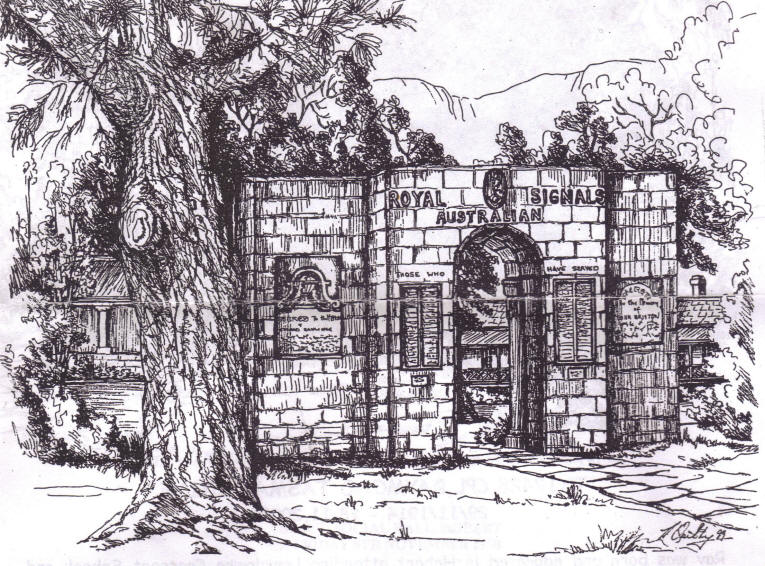

ROYAL AUSTRALIAN SIGNALS ASSOCIATION
(TAS)
Pictured above is a sketch of the Helen Quilty
painting of the Royal Australian Corps of Signals
Association Memorial at Anglesea Barracks, Hobart. It
serves both as a memorial to deceased members who served
in the Corps and the entrance to the Memorial Corner
where there is a commemorative wall containing twenty
two military headstones relocated from the old St
David’s Park burial ground and an elaborate memorial to
the 99th Regiment.
The archway in the memorial was retrieved from
the old Bath Inn near Lemon Springs, a few kilometres
South of the Oatlands township. Some thought that the
name Bath Inn was derived from the insignia of a bath
above the front entrance but the real reason was because
it was in the District of Bath.
The original Bath Inn was located at the Lemon
Springs homestead some two kilometres away where John
Page held the licence in 1833. When the new road was
opened in 1843, John Page built a new
Bath Inn of fine stonework and a fanlight above the front
entrance. In 1863 the name was changed to the Coach and Horses
Hotel and was owned by Denis Bacon, a celebrated stonemason.
The old newspaper cutting advertising the Coach and Hoses
Hotel still shows J Page as the Proprietor.
The name Lemon Springs dates back to 1808 when
Tasmania’s first bushranger, Richard Lemon was operating in
the area and one of his gang named Mansfield promised to
procure some supplies but instead turned up with two bottles
of rum. Lemon and his compatriot consumed the rum and next
morning Mansfield shot the still drunken Lemon in the head and
claimed the reward.
The former Commandant of 6th Military
District, Col. K R G. Coleman MC eventually became the owner
with the intention of restoring the old inn and converting it
into a Tea Room, but unfortunately, vandals destroyed it by
fire in 1971. The Col. Comdt. Royal Australian Signals 6 MD,
H/Col John H Hall then bought the property and used most of
the stone to enlarge his “Wash Cottage” at Andover.
Col. Hall was also President of the Royal Australian
Signals Association (Tas) and arranged with 6 MD Headquarters
to have the stone archway entrance to the inn removed and
re–erected in its present position as the main feature of the
Signals Memorial. Sappers of the 21st Construction
Squadron took three weeks to erect the archway and face the
reverse side with Pontville stone. Headstones of two British
soldiers are let into the reverse side of the wall, one on
either side of the entrance.
This fine example of Colonial architecture was
dedicated as the Royal Australian Corps of Signals Memorial by
Army Chaplains on the 12th October 1974. Members of 146 Signal
Squadron, 124 Signal Troop and Association Members accompanied
by the Army Band marched from the Officer’s Mess to the
Memorial. The Hon. Sir Stanley Burbury KBE unveiled a bronze
plaque and addressed the gathering. The Director of
Communications; Col. Ray Clark read the “Corps Collect” and
former President; Mr. Donald Hughes recited “The Ode of
Remembrance”. The bugle calls were sounded, followed by the
Royal Salute and March Off.
To mark the occasion of the 50th.Anniversary of the
Association in 1995, the rear of the Memorial was upgraded as
shown in the painting and a solid bronze plaque depicting
eighty names of those who had served the Corps and passed on
was unveiled The 50th Anniversary functions included
Commemoration Day, 15th October 1995 when the Princess Anne
Banner was paraded at the Memorial
In the year 2000 the Association commissioned Helen
Quilty, daughter of Past President, Secretary and Life Member,
Mr Donald Hughes to produce a watercolour of the Memorial to
mark the 75th Anniversary of the formation of the
Corps. The painting was officially unveiled at the statewide
Association Reunion held in Launceston on 4th March
2000. The painting was later presented to the Military Museum
for display in various army offices at Anglesea Barracks and
at present is hung in the Museum. The Memorial has been the
focal point of Remembrance each Anzac Day and Commemoration
Day since 1975 until the year 2006 when it was decided to
delete the Anzac Day service from the Association diary.
(Continuing the tradition, since 1995, the Association has
continued to collect the names of members/former members of
the Corps who wish to have their names added to the Memorial
Wall. Once each group of 40 names is achieved, another solid
bronze plaque is struck and mounted on the wall. As a
temporary measure, until each 40 person group is complete,
temporary metal nameplates are mounted. Families of deceased
Corps members can also arrange to have the name of their
relative included on a future memorial plaque by contacting
the President or Treasurer to make the necessary arrangement.
The fee ($20 members, $50 non-members) for each name to
be included on a plaque also assists with the maintenance of
the Memorial)
Fees can be remitted via post (cheque or
money order) to the Treasurer, 170 Molesworth Rd, MOLESWORTH
Tas 7140.